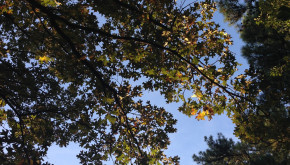
It is too late to prepare your forest for the drought of 2012, but some forest management practices may help prepare your woodlands to better cope with future weather extremes. Correctly planned and executed thinnings, harvests, and control of grapevines and invasive plants can all improve the vigor and resilience of individual trees and the forest as whole. The Forest Improvement Handbook provides information on management practices to improve forest health.
Watering forest trees is impractical or impossible. Drought has been and will continue to be a natural part of forest processes that sort trees onto the sites where they are best suited. Scout your woods for signs of drought damage or death. Look for trees with recently dead or dying upper limbs, areas of bark dying and peeling, particularly on the upper trunk, evidence of wood borer damage to trunks or branches, and sprouting of new limbs and leaves at the base or on the trunk of larger trees. Remember that these symptoms may appear during a drought or up to several years following the drought. If you experience tree decline or death, you may want to salvage useable wood for personal use or for sale to the wood using industry. Consult a professional forester for advice and assistance with timber harvests and other forest management.
Two publications to assist you with decisions related to selling timber are:
Tips on How to get the Most from Your Timber Harvest
Marketing Timber
To protect your forest from wildfire, observe all outdoor burn bans. Be aware of ignition sources that might not be obvious – exhaust systems on vehicles in contact with dry vegetation can start fires. Tilled or bare soil can provide firebreaks to prevent wildfire spread.
(submitted by guest poster Lenny Farlee, Extension Forester with the Hardwood Tree Improvement & Regeneration Center at Purdue University)
